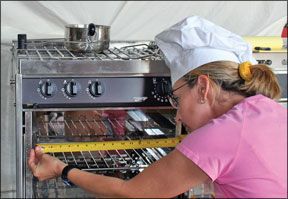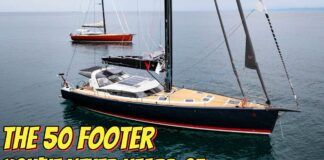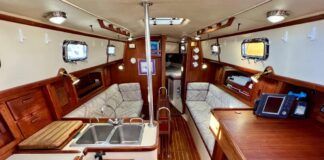We received four galley ranges for our test&emdash;three propane stoves and one alcohol stove. The propane models were: Force 10 Gourmet Galley (Model 63351), Seaward Princess Model 3175, and Tasco Model 755LP. The alcohol-fueled Origo 6000 by Dometic was the only non-propane stove we tested. Our hunt for the best marine stove looked at the stoves construction, durability, performance, safety, size, and price.
****
To say that the stove you select for your boat is a choice you will live with every day is not much of a stretch. That stove will be looking back at you every morning when you fire up the burners for coffee in a quiet anchorage, and during every roll of your boat during a storm. Whether youre baking bread during a crossing or just breaking eggs shoreside, its good to know whats cooking in the marine stove market.

What We Tested
In this review, the third in a three-part series on galley stoves, we contacted all the major stove manufacturers and asked for multiple-burner, stove-oven combinations for cruising sailboats. We received four stoves for our test&emdash;three propane-fueled stoves and one alcohol-burning stove. The propane models tested were: Force 10 Gourmet Galley (Model 63351), manufactured in British Columbia; Seaward Princess Model 3175, made in Whittier, Calif.; and Tasco Model 755LP, manufactured by the Taunton Stove Co. in North Dighton, Mass. The alcohol-fueled Origo 6000 by Dometic (an international company with addresses around the world) was the only non-propane stove we tested.
Alcohol-burning stoves of the past used a pressurized system that put out about half the heat of propane at twice the cost per hour. The Origo 6000 uses a wicking action with no pumping and no pressurized alcohol. It produces heat equivalent to that produced by propane by burning a greater amount of alcohol. A typical burner on a propane stove puts out about 5,000 BTUs. Origo claims to get 7,000 BTUs per burner, making it highly competitive against the three propane stoves we tested.
In this review, we looked at the stoves construction, durability, performance, safety, size and price. Heres a look at how they fared.
Force 10 63351
The Force 10 stove immediately stood out in this line-up, with its mirror-polished 304 stainless steel exterior and built-in pot holders.
The three-burner stovetop has stainless steel caps screwed in place over each burner, eliminating rattle underway and protecting the stoves thermocouples (temperature sensors that automatically shut off gas flow when the flame is extinguished) and gas jets from spills. This also keeps the caps in place during extreme conditions. The downside? You need a screwdriver to clean the burners, but well gladly deal with the extra cleaning step to be free of an irritating rattle. It also has a 2-inch lip on all sides to keep spills from ending up in the oven or on the cook. The grill grate lifts easily for cleaning and can be detached and removed for more extensive cleaning.
The Gourmet Galley model has two 4,100-BTU front burners and one 8,200-BTU back burner. Although the back burner failed to boil water significantly faster in our tests, it simmers well and offers a wider flame for sauces and big pots. The Tasco is the only other stove tested with a larger back burner.
The Force 10 burners are easy to use, with electronic lighting and ergonomic control knobs. The knobs must be held all the way in for 20 seconds to heat the thermocouple before a flame can be retained.
One nice feature is that the “high” flame setting is at the top of the burner-control dial, while the “low” flame setting is at the bottom, with a stop installed at the bottom. To turn the flame off, one must turn the dial up and past the “high” setting; you cannot accidentally turn the flame off when trying to coax it into its lowest setting.
The Force 10 has a 10-second cut-off time for safety. The feature, called a flame failure device (FFD), activates when a flame on either the burners or inside the oven is accidentally extinguished; the gas flow is stopped 10 seconds after flame-out.
The typical propane burner at 5,000 BTUs will boil two cups of water in about 4 minutes. The Force 10 (which clocked in at 6 minutes in several boil tests) was slower than both the Tasco and the Origo to boil water, but by only 90 seconds and 30 seconds, respectively.
The pivoting pot holders are easy to install and adjust. They effectively cover both the front burners and the back burner. After some time, the pot holder bases were showing signs of rust.
Force 10s signature feature is its fold-away oven door. When opened, the oven door tucks into a slot below the oven and, without the weight of the oven door pulling it forward, the stove tilts very little on its gimbals.
Practical Sailor found that, although it takes a while to get used to the oven handle lock and the open-and-shut motion, this feature is handy in a tight galley. The major drawback is that the oven door easily unlatches with an upward bump. If a cooks knee or a childs head inadvertently bumps the handle up, the door drops open.
The oven has a thermostat but no thermometer, and the readings on our Fluke thermocouple (placed in the center of the oven) read between 50 and 100 degrees below the number testers set on the Force 10 oven thermostat dial. The Force 10 oven is the only oven tested that has a separate oven-top broiler.
The oven took longer than the Seaward and the Tasco to heat up to 350 (by 2 minutes). Force 10 representatives explained that the oven has a lower heat output (and takes longer to heat up) to enable better control and even cooking.
“In a small oven cavity such as a marine stove, a higher oven output does not mean that it is better,” Force 10 Vice President Brad Clark told
Practical Sailor. “The trade-off for a fast heat-up time is usually poor regulation and a very poor low end temp setting.”
Testers found this to be true as the Force 10&emdash;once it reached the desired temperature&emdash;out-baked all three other ovens in the pizza-cooking and brownie-baking tests. The pizza crust came out with just the right combination of crisp edges and soft center, and the cheese was cooked without being burned. The brownies were baked all the way through with a cake-like center and no over-done spots or gooey, underdone spots.
Some Force 10 models are specifically equipped to burn LPG while others are equipped to burn CNG. The two are not interchangeable but a conversion kit is available.
Bottom Line:
Designed and made for the offshore cruiser, the Force 10 takes the cake by a sliver. Top-quality construction with all safety features, it out-cooks&emdash;and likely could outlast&emdash;the other stoves in our test. Its our Best Choice.
Origo 6000
Origo has managed to resolve consumers major concerns about alcohol cookers by developing a stove-lighting system where all the cook has to do is open a flue and light the burner directly. No pumping is needed; no pressurized alcohol is needed.
And our tests showed the burners boiled water nearly as fast as the propane stoves. The Origo 6000 stovetop has a small lip to contain spills. The grate does not lift up for cleaning. The burner knobs are hard to turn, but thats because you are actually opening a flue. The dials on the knobs run from low to high counter-clockwise, making it more of a challenge to adjust the flame to simmer without accidentally turning the flame off.
Although the boil times were about the same as the propane stoves, the Origo oven took significantly longer to warm, heating up to 350 F in 12 minutes. (Compare that to the other ovens average time of 6 minutes). The oven door can be opened with one hand, is spring loaded, and locks on closing. In place of thermostat settings, the oven has numerical “0-4” settings and a thermometer inside the oven, although this tends to fog up during cooking. There are two shelf options inside the oven, with no lock to keep shelves from sliding out.
Practical Sailornoted that a 9×13 pan&emdash;a standard size baking pan&emdash;cannot be used on the top shelf because the oven thermometer, on the left front interior, blocks a couple of inches of the shelf. The pan can be used on the lower shelf. The Origo brochure recommends a maximum pot size of 9 inches in diameter for the stovetop burners.
The spring latch that you have to press down to open the oven door gets very hot when the oven is in use and can’t be touched with a bare hand. The same is true of the oven door and the handle.
In our baking tests, the Origo heat distribution wasnt as even as the propane stoves. The pizza crust started to burn around the outside while the middle was still soggy. The cheese was melted but did not cook. The brownies took longer to cook and finished with over-crisp edges and a soft center, but would certainly be eaten.
As noted in our last tests, the Origo burner tops rusted fairly quickly after the salt water spritz test. Origo, a company which regularly receives kudos from Practical Sailor readers, says it will replace these free of charge. Rust streaks were also noted on the stove body, but these cleaned up fairly easily.
Bottom Line:
Origo has managed to eliminate many of the fears and hassles associated with alcohol stoves. The oven doesn’t offer terrific heat regulation, but if you want to skip adding a propane locker to your boat the Origo foots the bill.
Seaward Princess 3175
The Seaward Princess boasts a sleek, stainless steel design on the exterior with three 7,000-BTU burners&emdash;two in the front and one back burner. The burner tops and the oven interior are coated with porcelain enamel found in conventional home ovens, allowing for a pretty look, good heat distribution, and an easy clean up. The Seaward manual states that the porcelain is not extremely delicate but that it is glass and must be treated as glass. The two-year warranty clearly excludes it. Sharp blows can cause the enamel to chip or crack. According to the owners manual, foods with acids&emdash;vinegar, lemon juice, tomatoes, and milk&emdash;can also dull the finish.
Stovetop burners are topped with two-piece porcelain caps. These caps distribute heat well and are easy to clean as they lift right off of the burners. The tradeoff is having another loose part that can rattle or get loose in a knockdown or rollover (when loose stove parts are the least of your worries).
The Seaward is the only stove in the test that boasts deep, wide, individual spill pans around each burner. There is a minimal lip around the stovetop, though.
The pot holders can be arranged to reach either front burner but not the back burner. Youll want to put a burr in the knobs threads so that the knob wont twist all of the way off.
The Seaward has a convenient 12-volt piezo-electric lighting system; no lighter is needed to fire up the stove burners or the oven pilot. A 4-foot cord with AC/DC transformer can be plugged into an AC outlet, or the cord can be wired directly into the ships 12-volt system.
The Seawards thermostat system uses a pilot light. This remains lit when baking, while the burners turn off and on as needed to control oven temperature. The stove and oven control knobs are easy to turn and clearly marked, but they do pull off easily.
Porcelain coating on the oven interior makes for a nice looking, easy-to-clean surface. A heat distribution plate at the bottom of the oven is attached via two screws. The oven has a thermostat to control temperature, but there is no thermometer. The oven light is a nice feature not found in the other stoves. The brushed stainless oven door is spring-loaded, nicely balanced, and needs 6 pounds of pull to open. There is no way to lock the door closed.
The oven heats up quickly, but it was difficult to control the temperatures. Our Fluke thermocouple showed oven temperatures rise quickly, then slow down but continue to rise at a slower speed; they don’t level off. Our test pizza cooked too quickly on the bottom, browning the crust before the cheese cooked on top. The brownies fared better and were about the same quality as those cooked in the Force 10. Both pizza and brownies were better than those cooked in the Origo and the Tasco.
Bottom Line:
The Seaward Princess oven wont hold up to abuse that the Force 10 will, but it is easy to clean and performed well in the boiling and baking tests. A very close second, and at nearly $250 less than the Force 10, we give it the Budget Buy.
Tasco 755 LP
The Tasco has two 6,000-BTU front burners and a larger, 10,000-BTU back burner. The burners are topped with attached porcelain caps that wont lift or fall off and are easy to clean. The stovetop has a small lip all around to contain spills. The grate lifts up for easy cleaning but does not detach.
The burners and oven are easy to light with Tascos piezo-electric lighting, powered by a 9-volt battery. The knobs on the test stove came off easily, and one lost its glued-on label that showed what direction to turn the knob for “high flame” or a “low flame.” Without the label, the cook must watch and listen for the flame to decide whether the burner needs adjusting.
The oven door is secured by a lock, and two hands are required to open it&emdash;one to release the lock and one to open the door. The door is spring loaded with an automatic lock that engages when the oven door shuts. The Tasco is the only model in our test that has both a thermometer and a thermostat, but its also the only model without a glass door. The thermometer has both Celcius and Fahrenheit readings.
The oven door handle is plastic coated, allowing the cook to open the oven while its in use without donning a glove. The oven interior is polished to a mirror finish and cleans up easily. The locking shelf has two mounting options.
The Tasco, in repeated boil tests, boiled faster than the others, with an average of about 4 minutes. The water temperature increased quickly, compared to the other two propane stoves. Although the stovetop temperatures and the oven temperatures shot up quickly, the brownies took longer to cook in the Tasco, and it was harder to adjust the interior oven to the called-for pre-heat temperature. The oven didnt seem to self-adjust (as measured by our Fluke thermocouple), so we tried feathering the dial up and down to try to get the stove to stick to the right temperature. The oven does have a temperature knob and a thermometer, so you can monitor and adjust the temperatures.
The Tasco-cooked pizza didnt fare well, with partially browned, partially soggy crust and under-cooked cheese with temperatures set at 425 F. The brownies werent cooked as evenly as those baked in the Force 10 and the Seaward. The outside edges were slightly overcooked while the brownie center still gooey.
Bottom Line:
The Tasco is a well-made stove with excellent seagoing features like attached burner caps, high sea rails, and a large oven. Overall, however, it was not up to par with the Force 10 and Seaward Princess.
CONCLUSION
All four stoves are well constructed and meet safety standards, and all would fit the bill for a weekend cruise or a day sail.
For the serious cruiser, both the Force 10 and the Seaward Princess are built to last and can cook up storm&emdash;and cook through one. The irony is that the best feature for each is also its drawback feature: The Force 10s unique fold-away door opens easily when bumped, and the Seawards porcelain finish offers excellent heat distribution, looks great, and cleans easily, but it can be chipped by hard use.
The Force 10 gets the edge by a whisker for Best Choice honors, while the Seaward is the Budget Buy.





































